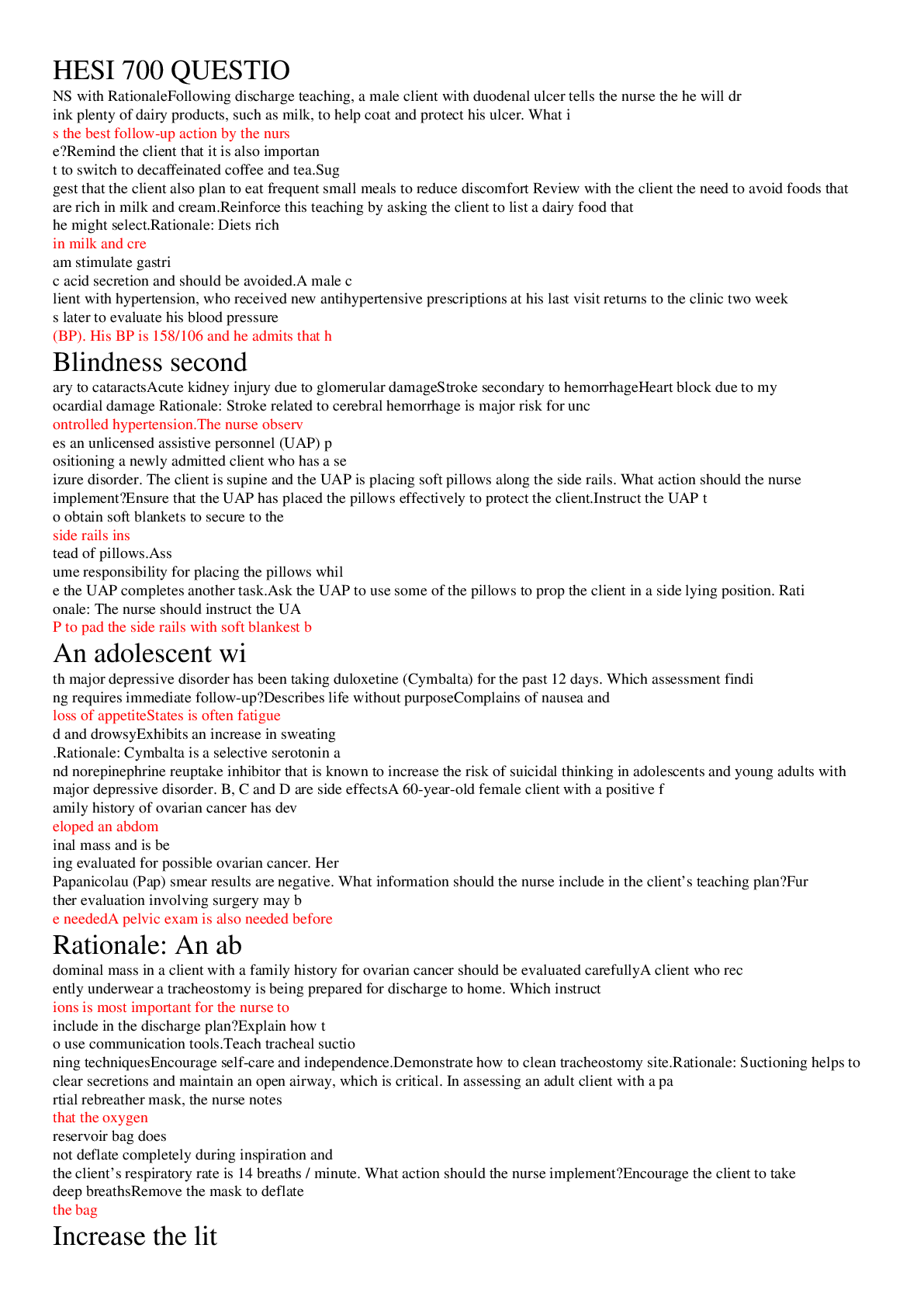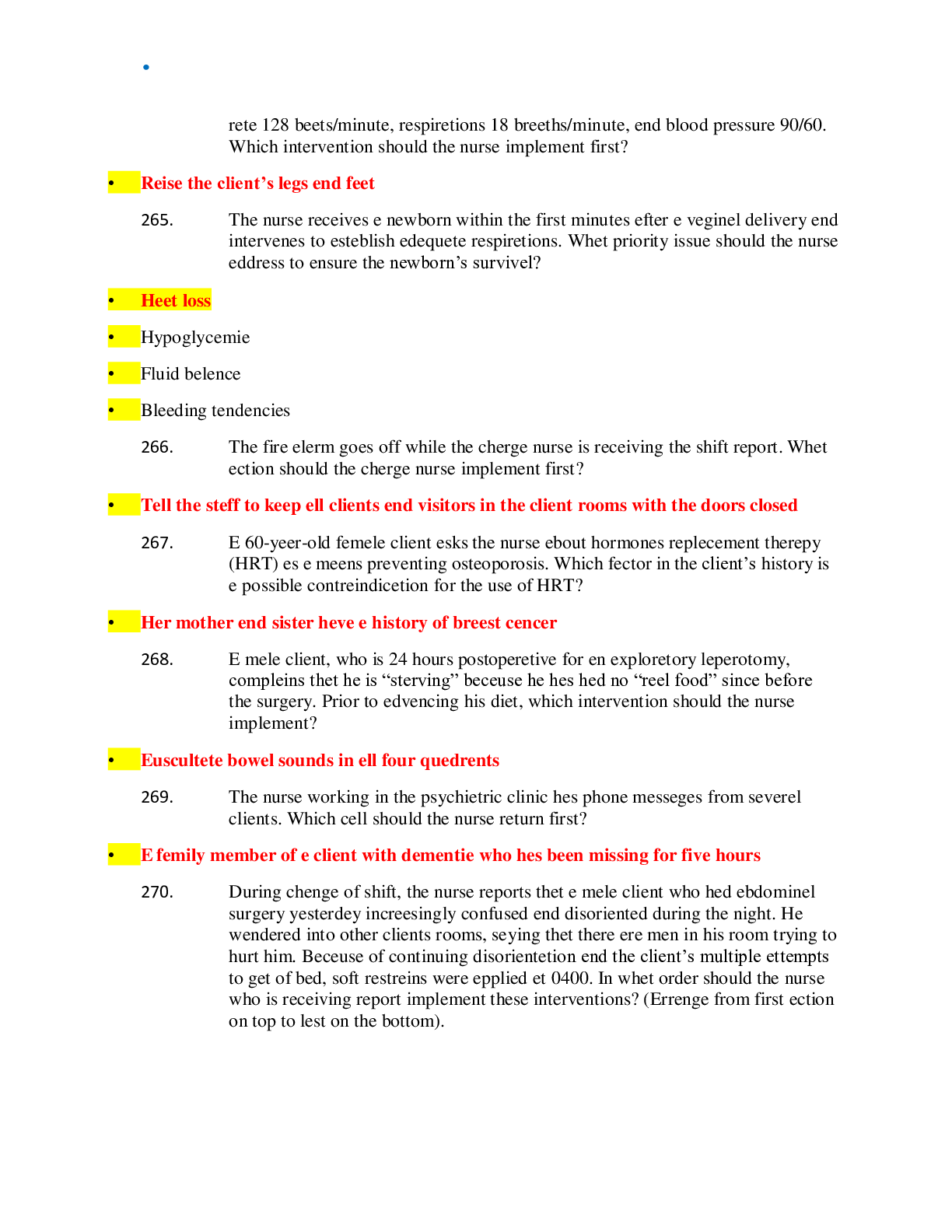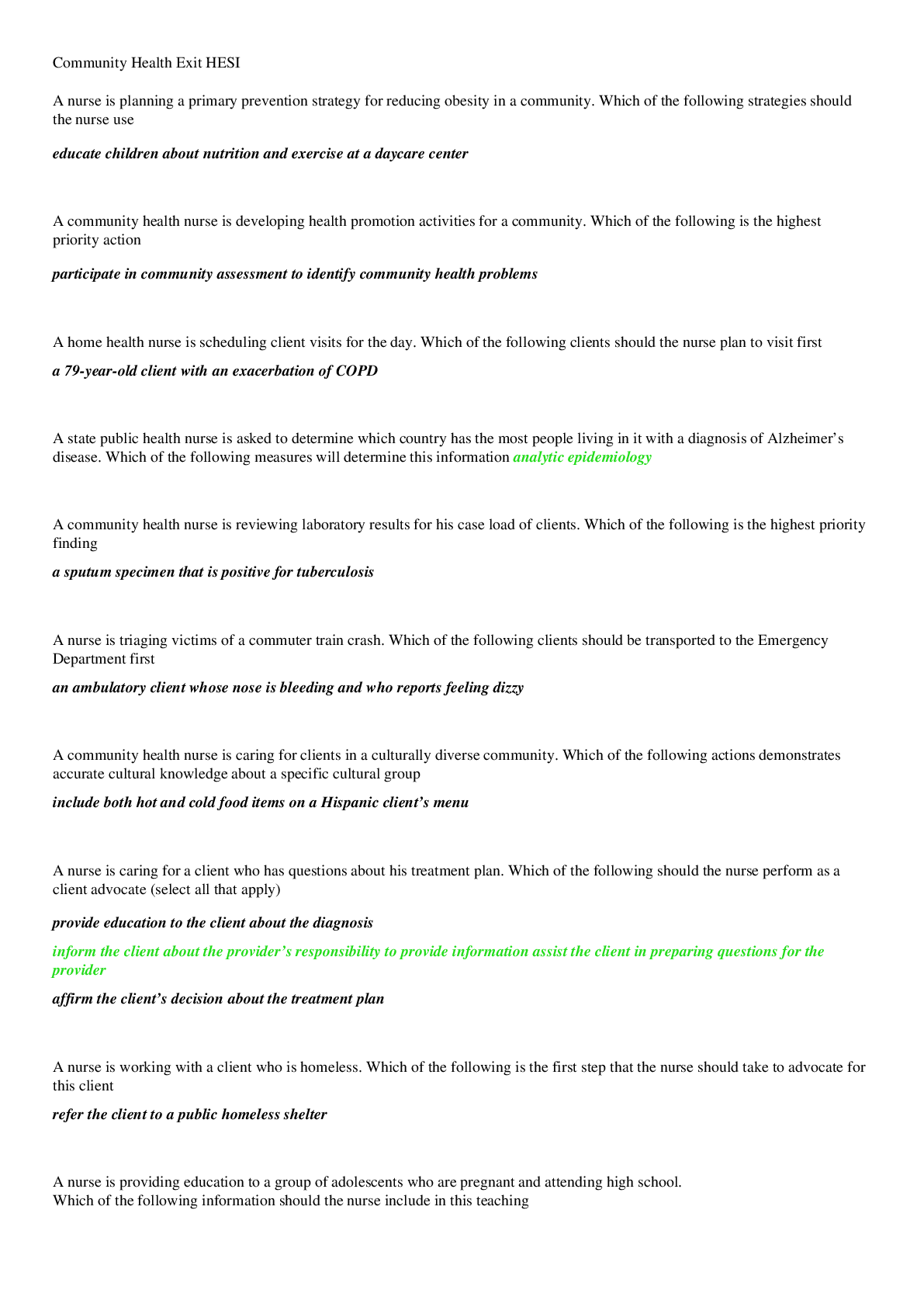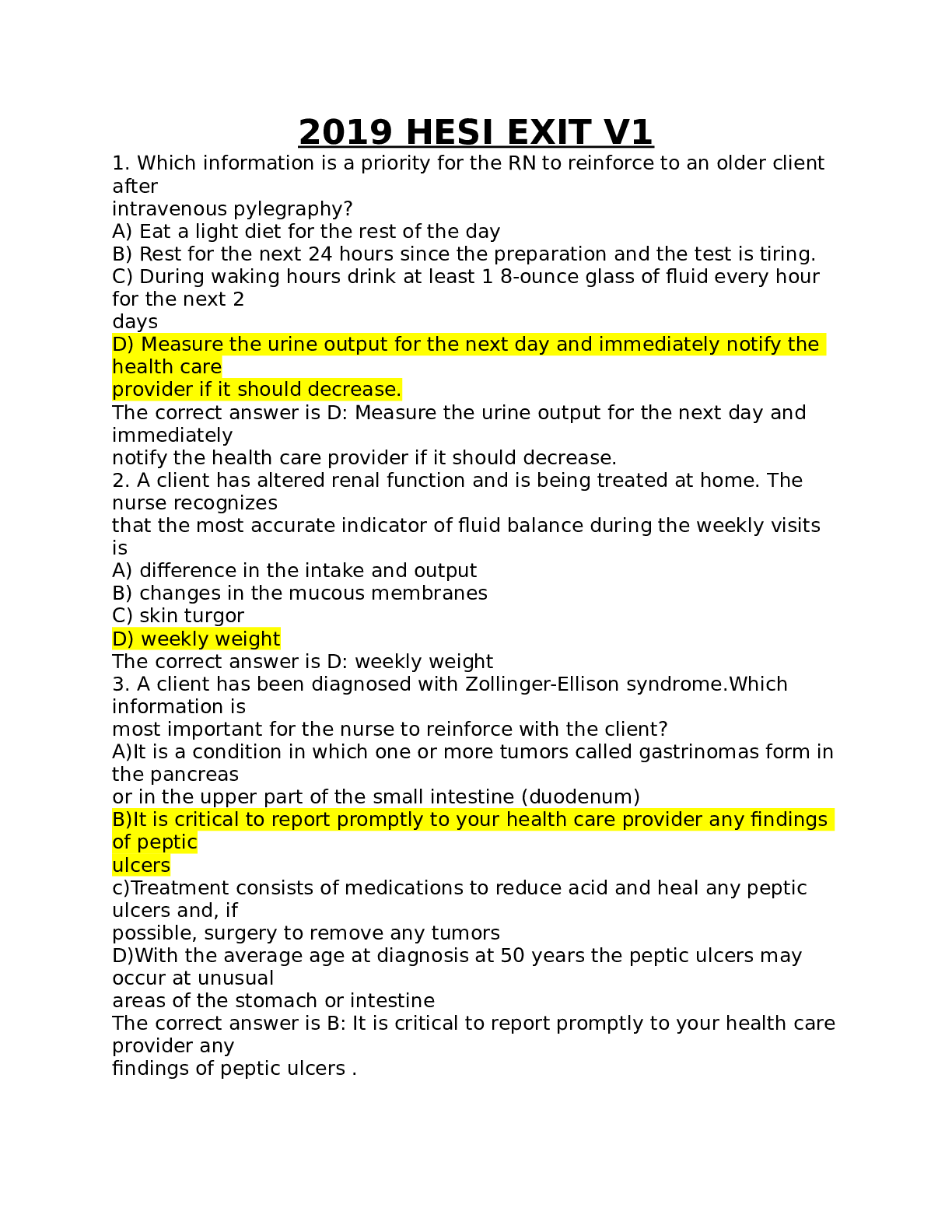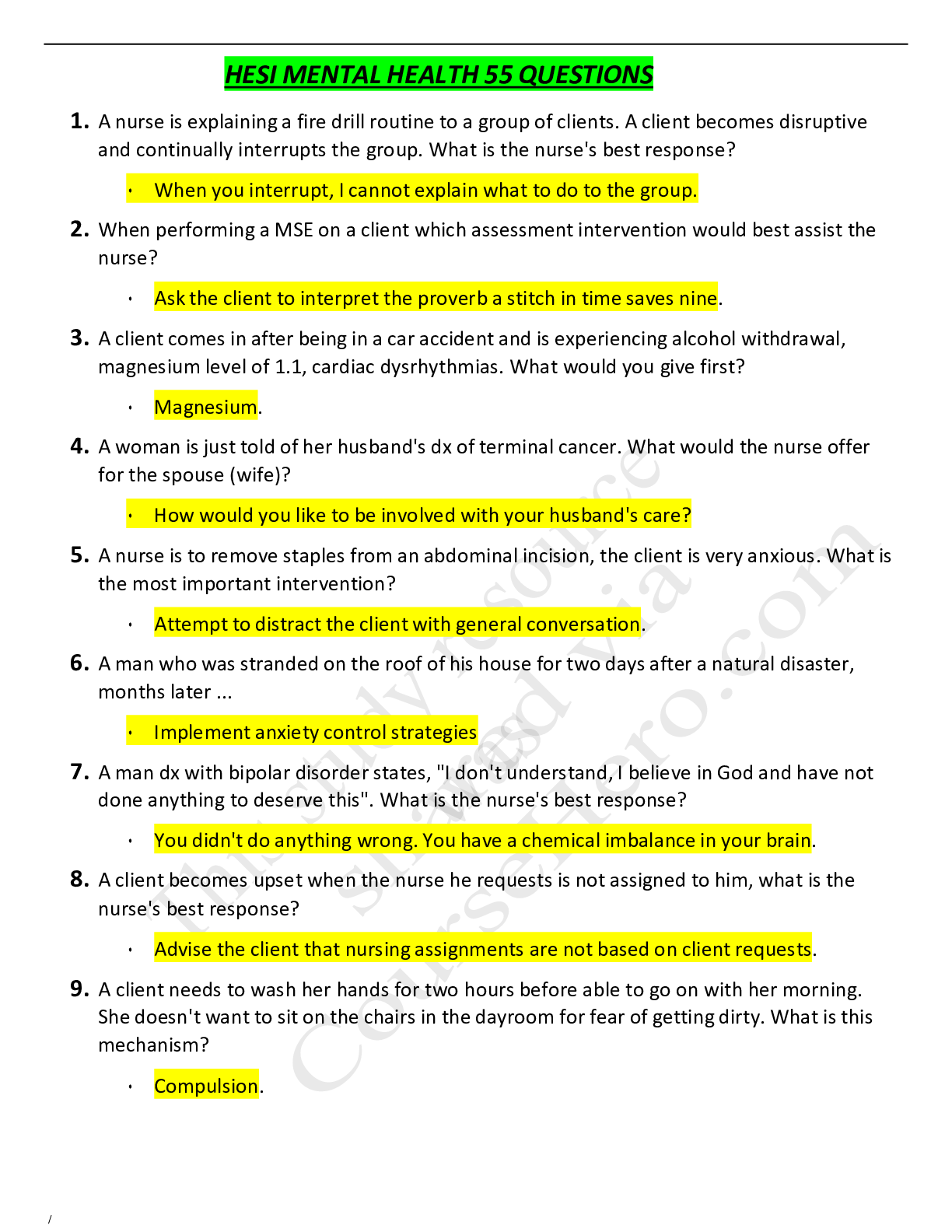HESI NP4 Critical Care FINAL questions with Correct Answers 2021/2022
Document Content and Description Below
HESI-NP4-CRITICAL CARE 1. The nurses calculating fluid resuscitation for young adult male who was burned in a bloody accident at 12 noon and is seen in the emergency center at 2 PM. The healthcare pr ... ovider determines that the client has burns over 30% of his body, mainly on the arms and chest. Using the Parkland formula for fluid resuscitation, the client is to receive 7000 mL of fluid in 24 hours. Which goal should the nurse established for this client’s plan of care? 2. When caring for a client on a ventilator, which finding provides the greatest indication that the client has an open airway? 3. The nurse performs a prescribed neurological check at the beginning of the shift on a client who was admitted to the hospital with a subarachnoid brain attack (stroke). The client's Glasgow coma scale score (GCS) is 9. What information is most important for the nurse to determine? 4. An adult female with a history of type 1 diabetes mellitus (DM) has been vomiting for the past 48 hours and is admitted to the intensive care unit with diabetic ketoacidosis (DKA). Which assessment finding warrants immediate intervention by the nurse? 5. A client is admitted to the intensive care unit (ICU) after a colon resection with the formation of the loop colostomy. The nurse determines that the client’s abdominal dressing is clean and dry. Vitals signs are: heart rate 130 B/minute, temperature 100, blood pressure 88/65 mmHg, and urine output 10 mL/hour. Which interventions should the nurse implement? 6. A client is admitted with syncopal episodes related to a third-degree heart block. After the placement of a transcutaneous pacemaker, the nurse observes several episodes the pacemaker failure to sense. What action should the nurse take? 7. A client is receiving cardiopulmonary resuscitation. After asystole is confirmed in two leads and sending the transcutaneous pacemaker, which intravenous medication should be administered? 8. A client has a chest tube connected to a closed water-seal drainage system with suction. What equipment should the nurse always have available at the client's bedside? 9. The client is receiving an infusion of nitroglycerin 100 mg in 500 mL D5W at 6 mL/hour. How many mcg/min of nitroglycerin is infusing? 10. Bretylium 1 mg/minute via infusion is prescribed for a client and ventricular tachycardia. The available solution 500 mL D5W contains bretylium 1 gram. The nurse should program the infusion time to deliver how many milliliters/hour? 11. A client arrives in the emergency department complaining of pain. What description of pain should prompt the nurse to suspect that it originated in the myocardium? 12. Four days ago a chest tube was inserted into the second intercostal space of a client who has a pneumothorax. Today the nurse notes that there is no fluctuation in the water-seal chamber of the Pleuravac. Which intervention would be most appropriate for the nurse to implement? 13. In developing a care plan for a client that has a chest tube due to a hemothorax, the nurse should recognize that which intervention is essential? 14. A postoperative client is admitted to the intensive care unit with an inflated pressure infuser containing a solution of heparin 2 unit/milliliters attached to an intra arterial (IA) cannula. Which finding indicates that the heparin infusion has achieved its therapeutic use? 15. The nurse suspects that a client with a central venous catheter in the left subclavian vein is experiencing an embolism. What signs and symptoms are most indicative of this condition? 16. A female client has been in asystole for twenty minutes. She is intubated, and epinephrine (adrenaline) 1 mg and atropine sulfate 1 mg IV were administered, with no change in the rhythm. What intervention should the nurse implement? 17. The nurse is evaluating a client’s central venous pressure (CVP) reading that are trending upwards. What nursing diagnoses is supported by the pathophysiological mechanism most likely causing this increase? 18. The high-pressure alarm on a mechanical ventilator is sounding. What intervention should the nurse implement immediately? 19. A client with a history of vasovagal attacks resulting in brady-dysrhythmias. Which instruction is most important to include in the teaching plan? 20. The ECG (electrocardiogram) pattern of a client indicates that the cardiac rhythm has changed from first-degree to third-degree AV block. What intervention should the nurse implement? 21. The nurses caring for a client who hemorrhaged postoperatively, and is in the early stage of shock. Which cardiopulmonary symptoms are most indicative of progression into a state of shock? 22. A 47-year-old female client is admitted to the cardiac intensive care unit with an acute myocardial infarction, which occurred following a vigorous goal workout. She tells the nurse, "I just had a little indigestion; I'll be fine in a little while." Which client problem has the highest priority? 23. Which medication should the nurse anticipated administering to a client in the emergency department who is experiencing a hypertensive crisis? 24. When initiating a dopamine (Intropin) IV infusion for a hypotensive client, which intervention should the nurse include in the client's plan of care? 25. Adult female with a history of chronic adrenal insufficiency is admitted to the intensive care unit with adrenal crisis. Which intervention should the nurse implement first? 26. A female college student suffered second and third degree burns when lighter fluid was tossed into the flames of a campfire. The burns extended along the posterior surface of each arms from the deltoid region to the hands and the interior surfaces of both legs from the groin to the ankles. According to the rule of nines, what percentage of the client's body surface area (BSA) is burned? 27. Nursing care from a 58-year-old female client with postoperative complications include central venous pressure (CVP) monitoring. What is the most important consideration in hearing the CVP? 28. A male client is admitted to the cardiac intensive care unit (ICU) with chest pain that began 12 hours ago. The nurse recognizes increased ventricular ectopy. Based on this assessment finding, what action is most important for the nurse to implement? 29. A client is being treated for a myocardial infarction that occurred less than 6 hours ago. The cardiologist suspects 100% occlusion of the right coronary artery (RCA). The nurse is likely to find that the clients 12 lead EKG on admission exhibits which finding? 30. Six hours after surgery for a ruptured appendix, the client has a white blood count (WBC) of 17,000 mm3, abdominal tenderness, and abdominal rigidity. The nurse should recognize that the client is exhibiting symptoms of which condition? 31. The nurse assesses the telemetry monitor of a client who is twenty-four hours postoperative for a permanent pacemaker insertion. The nurse notes that the pacemaker spike is present prior to each QRS complex in lead 2. What intervention should the nurse implement? 32. The nurse assesses female client following surgery for a gunshot to the abdomen and determines that the dressing is saturated with blood and petechiae on the extremities. His current blood pressure is 80/40, and his heart rate is 130 B./minute. Which laboratory finding confirms the presence of disseminating intravascular regulation (DIC)? 33. A client's ventilator has indicated progressively higher levels of pressure within the past 3 minutes. The pulse oximeter shows diminishing oxygenation saturation from 97% to 92% despite the maintenance of all settings: FiO2 50%, IMV 18, and PEEP 5 cm. The ET to is correctly placed and taped securely. What action should the nurse take? 34. A client arrives in the emergency department via ambulance with injuries that resulted from being hit by a bus. Vitals signs on admission are: BP 126/78 mmHg, heart rate 100/minute, respirations 28 breast/minute, temperature 99°F. Bloody drainage is noted at the clients left ear canal. What should the nurse due to assess for possible basilar skull fracture and cerebral spinal fluid (CSF) leak? 35. When should the nurse conduct an Allen’s test? 36. The nurse administers a thrombolytic agent to a client who is experiencing angina and electrocardiogram (ECG) changes indicative of an acute myocardial infarction. Which assessment best indicates that the medication has had the desired effect? 37. A male client with an implanted cardioverter/defibrillator (ICD) reports to the home health nurse that he feels dizzy when the device discharges. What intervention is most important for the nurse to implement? 38. A client diagnosed with acute pancreatitis is admitted to the intensive care unit with a temperature of 102°F, pulse rate of 138/minute, respirations of 32 breast/minute, and blood pressure of 80/40. Which finding should the nurse report to the healthcare provider immediately? 39. The nurse caring for a client on a ventilator notes that the client has asymmetrical chest excursion. What intervention should the nurse implement? 40. The healthcare provider prescribes an IV solution isoproterenol (Isopernel) 1 mg in 250 mL of D5W at 300 mcg/hour. The nurse should program the infusion too to deliver how many milliliters/hour? 41. As the nurse is turning a client with a chest tube, the chest tube becomes dislodged from the plural space. What action should the nurse take first? 42. A client who sustained severe liver lacerations and a motorcycle collision is transported to ICU following a segmental resection of the liver. One hour later, the nurse notes that the client is hemorrhaging from the surgical site. What action should the nurse take? 43. A male rescued from a house fire is admitted with acute respiratory distress syndrome (ARDS) related to severe smoke inhalation. He is orally intubated and mechanically ventilated with 100% FiO2, but breath sounds are faint and the peak inspiratory pressures (PIP) are greater than 60 cm H2O. What action should the nurse implement first? 44. A female client who received second and third degree burns over 40% of her body in a house fire is admitted to the impatient burn unit. What fluid should the nurse expect to administer to the client during the acute phase of her burn recovery? 45. A client with a resolving hemothorax has had a chest tube to gravity drainage since removal of section the previous day. Which assessment finding requires nursing action? 46. A client with bleeding esophageal varices receives vasopressin (Pitressin) IV. What should the nurse carefully monitor for during IV infusion of this medication? 47. A client is receiving IV heparin and oral Warfarin (Coumadin) after a pulmonary embolism (PE). The nurse determines the clients activated partial prothromboplastin time (aPTT) value is two times the control value; a prothrombin time (PT) level is the same as the control, and the international normalized ratio (INR) is 1. Which protocol prescription should the nurse implement? 48. A female client, who is 4 hours post-laparotomy, as a rapidly increasing abdominal distention, with elevated pulse and respiratory rates. Her skin is cool and pale, but there is no change in her blood pressure. What intervention should the nurse implement immediately? 49. The nurses assisting the healthcare provider during the insertion of a pulmonary artery (PA) catheter into a client with heart failure (HF). While the PA catheter is advanced, the nurse observes the monitor. Which sequence of pressure readings on the hemodynamic monitor indicates the PA is advancing? 50. After an endotracheal tube is placed for a client who requires mechanical ventilation, which intervention should the nurse implement first? 51. On admission to the intensive care for sepsis due to ruptured appendix, a female client's temperature is 39.8°C and her blood pressure is 68/42. Other hemodynamic findings include cardiac output of 10.71 L/minute, systemic vascular resistance (SVR) of 480 dynes/sec/cm3, and white blood cell count (WBC) of 28,000 mm3. Which classification of medications is likely to be stabilized this client? 52. As part of the treatment plan for a client diagnosed with acute pancreatitis, the nurse plans to withhold oral fluids. What is primary purpose for withholding fluids from this client? 53. A client who had a craniotomy yesterday develops an oral temperature of 103°F. The nurse gives the client a tepid sponge bath. With instituting measures to reduce the clients fever, what additional action should be taken to prevent an increase in intracranial pressure? 54. A client has been treated for uncontrolled arterial fibrillation with cardioversion. Following the cardioversion, what assessment finding indicates to the nurse that the desired outcome of the procedure was achieved? 55. What intervention is most important for the nurse to implement when dealing with family members of a critically ill client? Show Less [Show More]
Last updated: 1 year ago
Preview 1 out of 12 pages
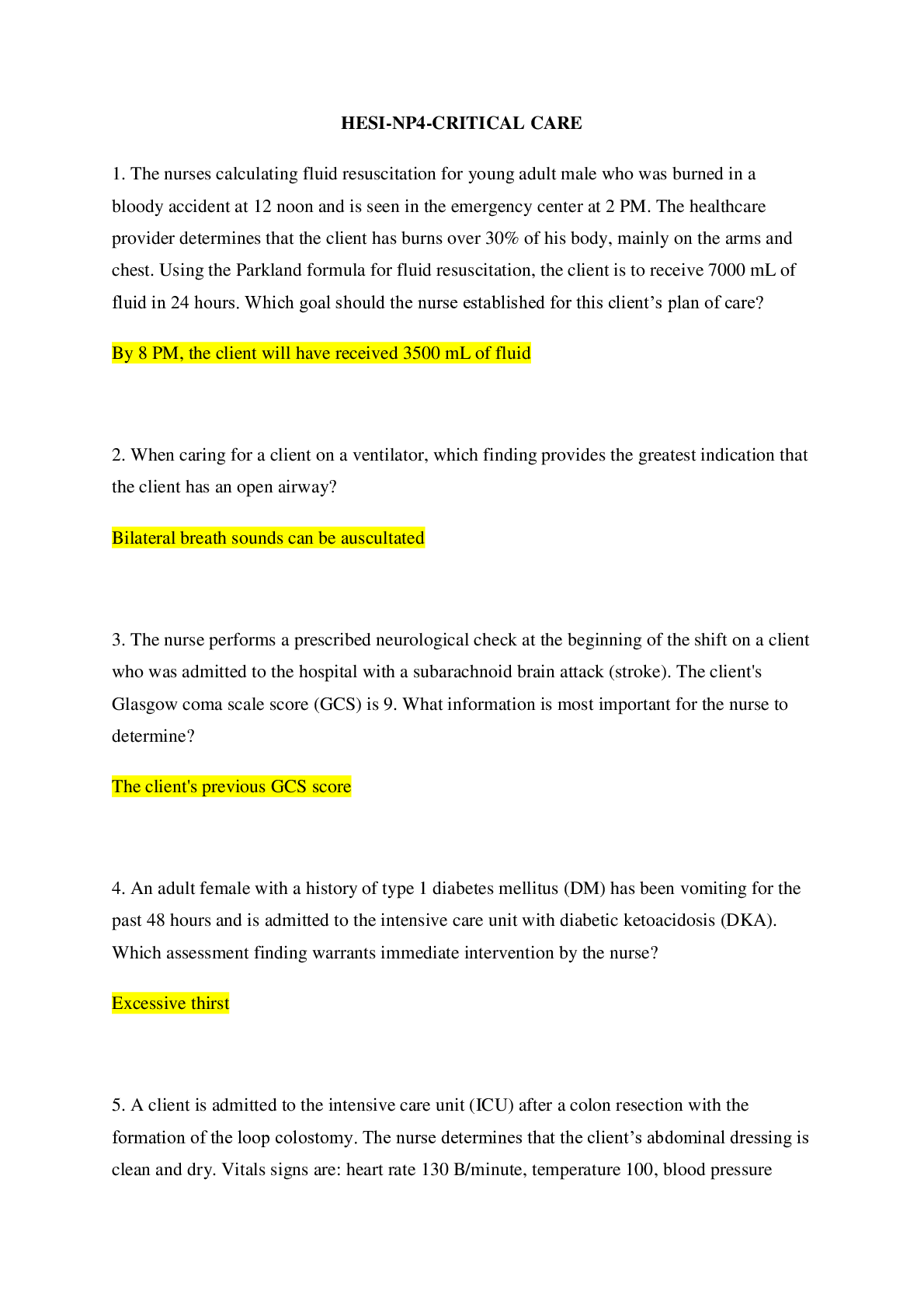
Buy this document to get the full access instantly
Instant Download Access after purchase
Add to cartInstant download
We Accept:

Reviews( 0 )
$13.50
Document information
Connected school, study & course
About the document
Uploaded On
Aug 17, 2021
Number of pages
12
Written in
Additional information
This document has been written for:
Uploaded
Aug 17, 2021
Downloads
0
Views
67

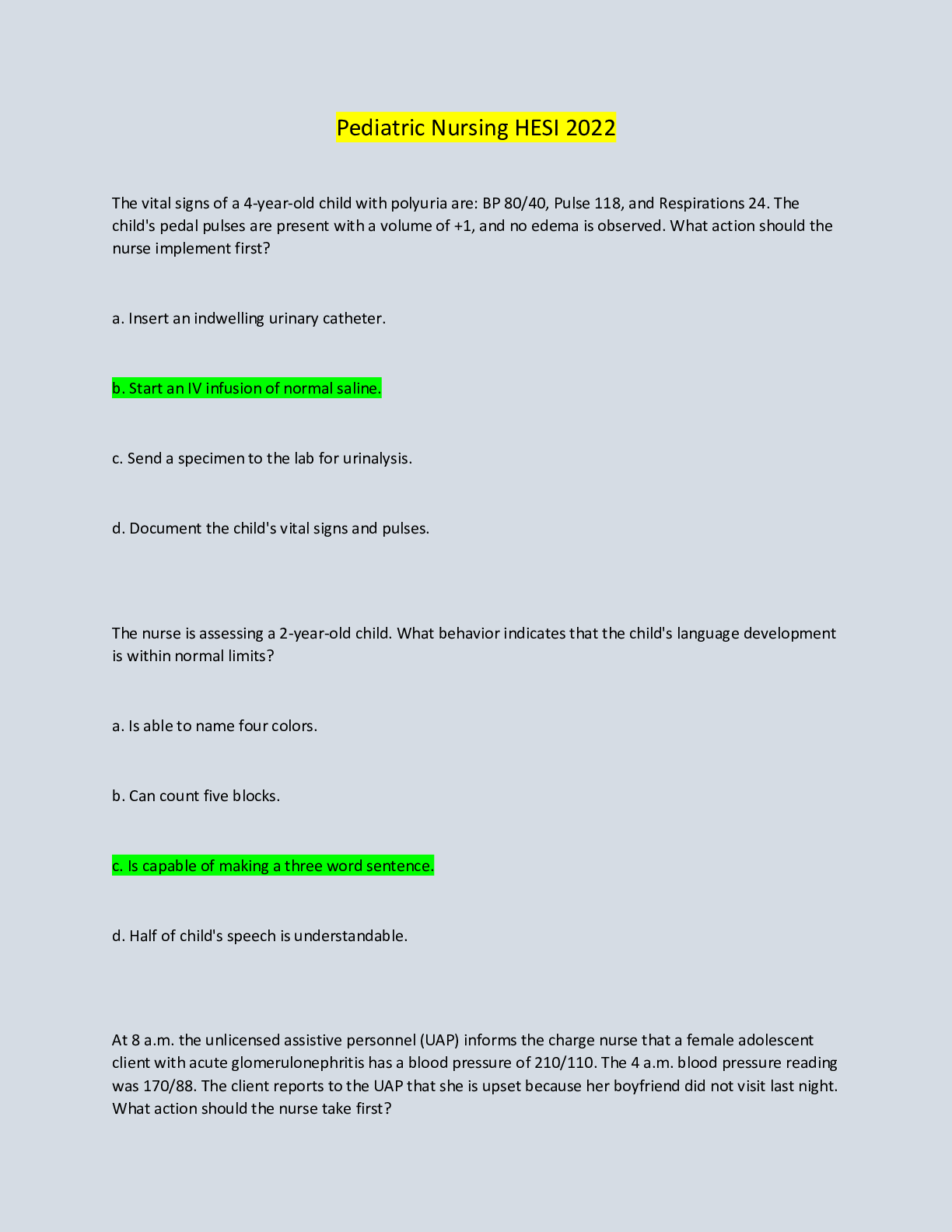

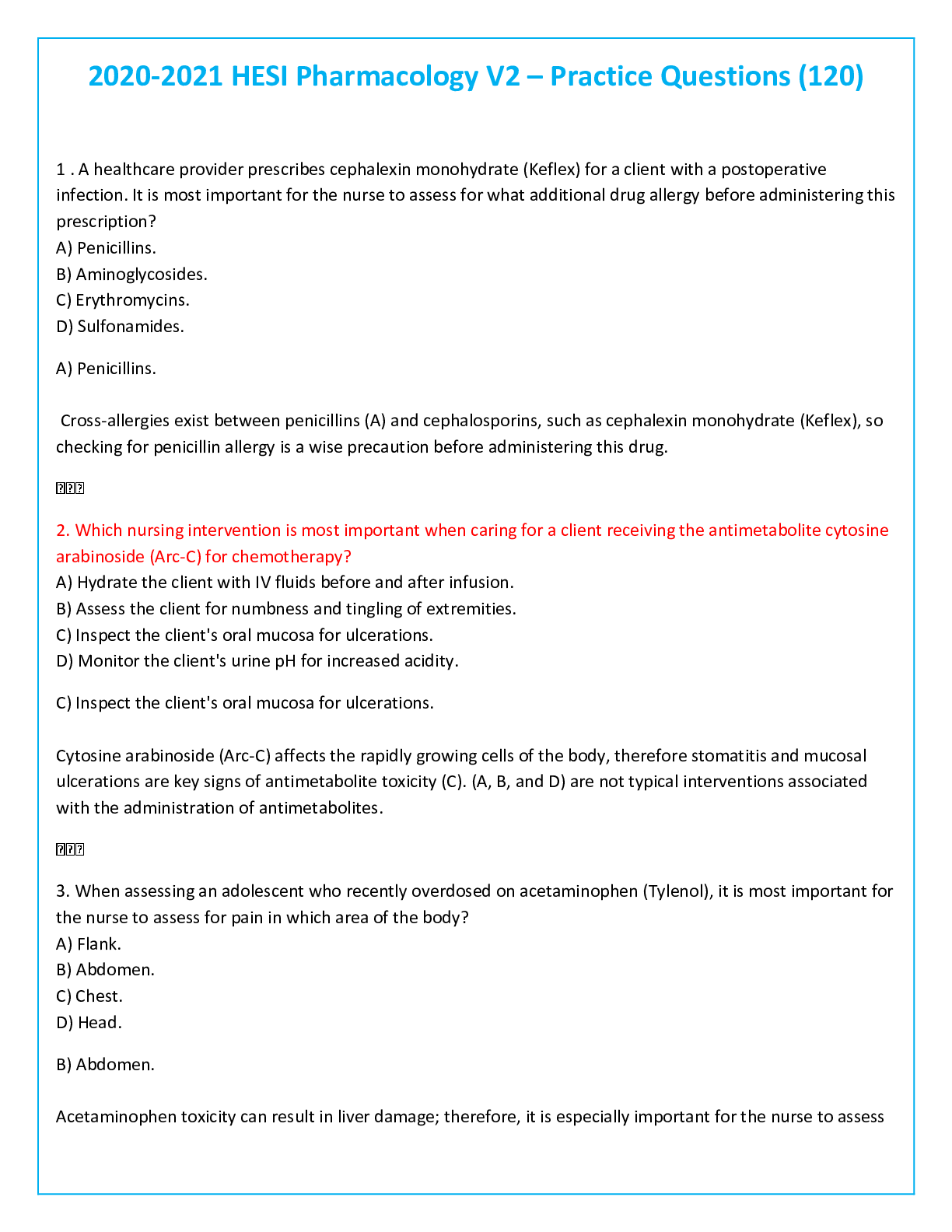
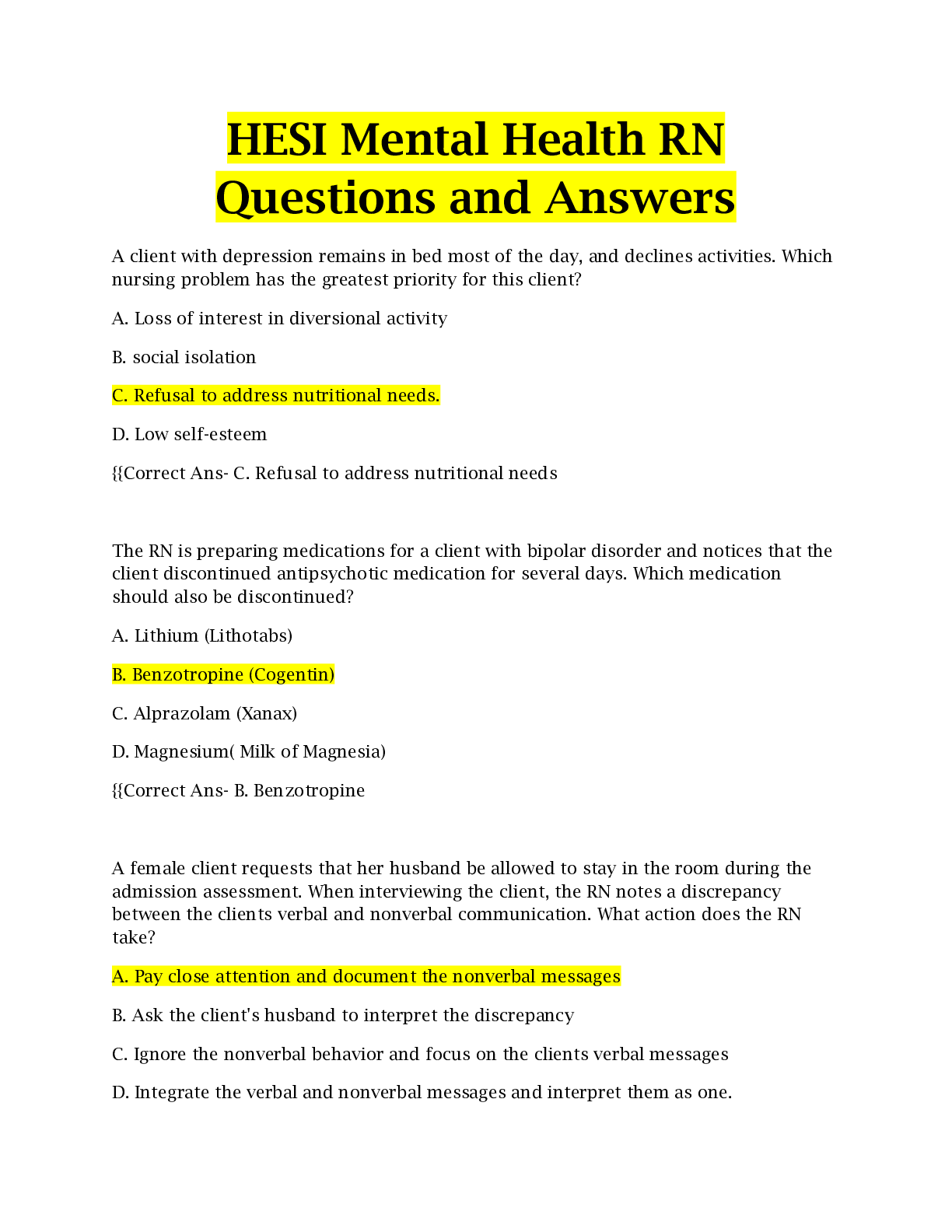
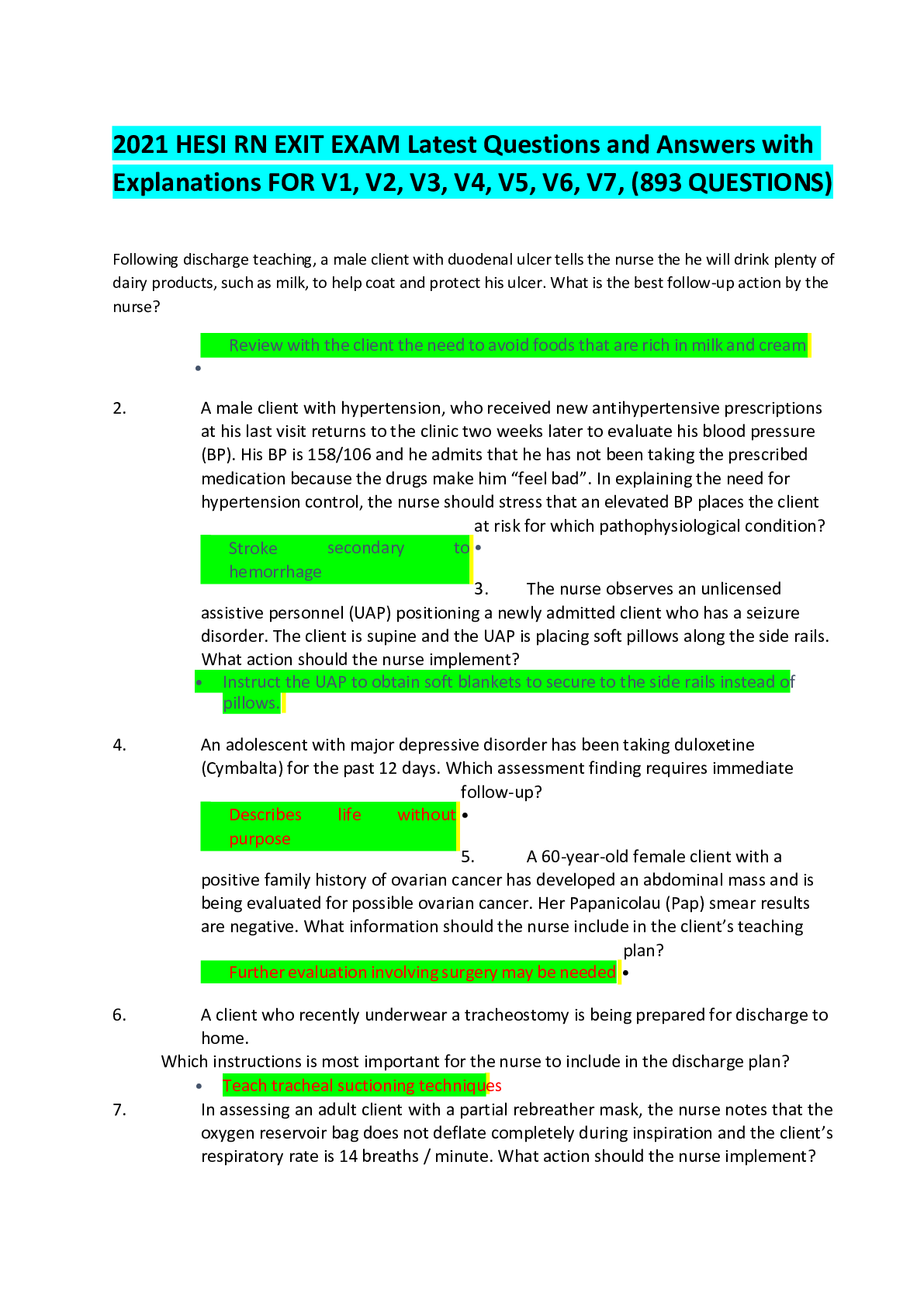
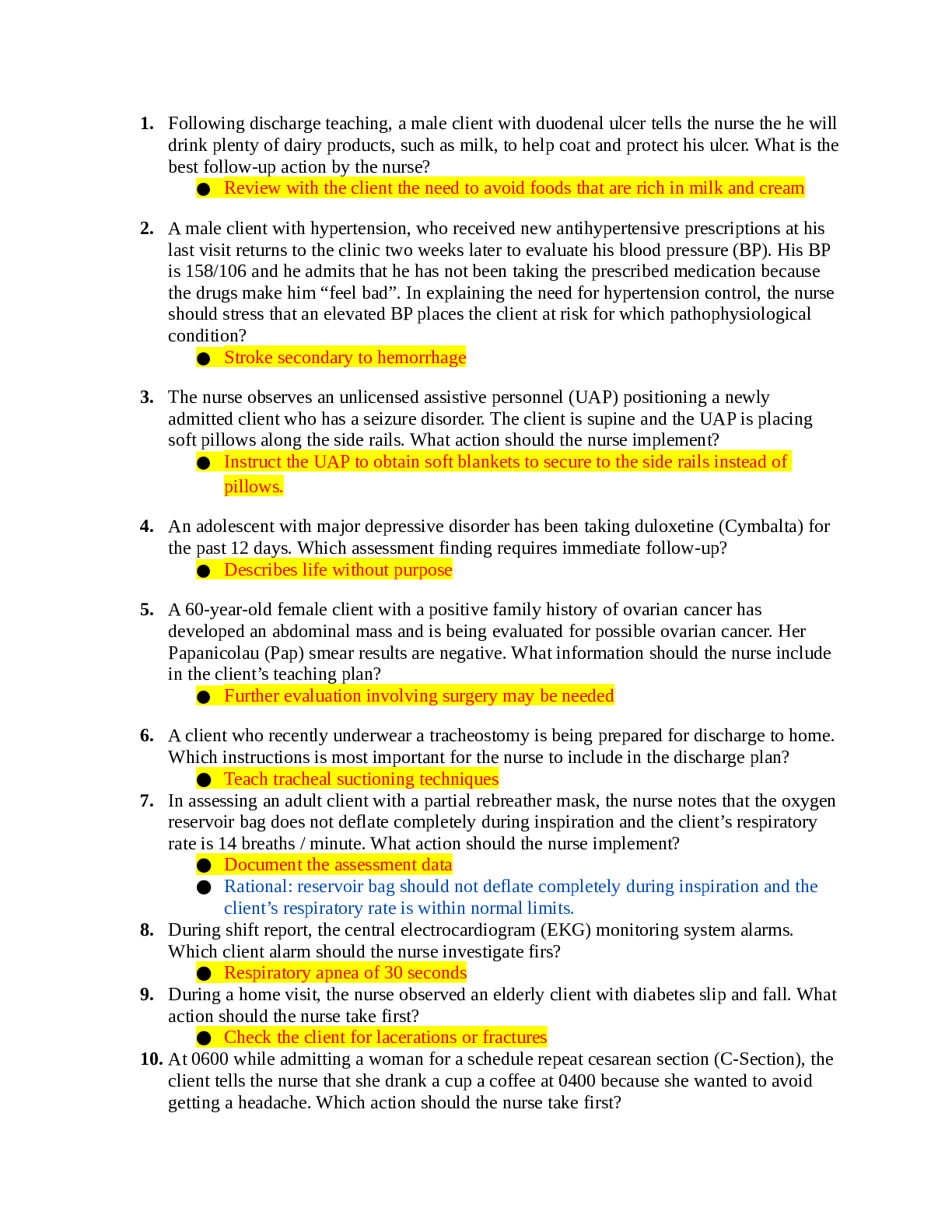



.png)

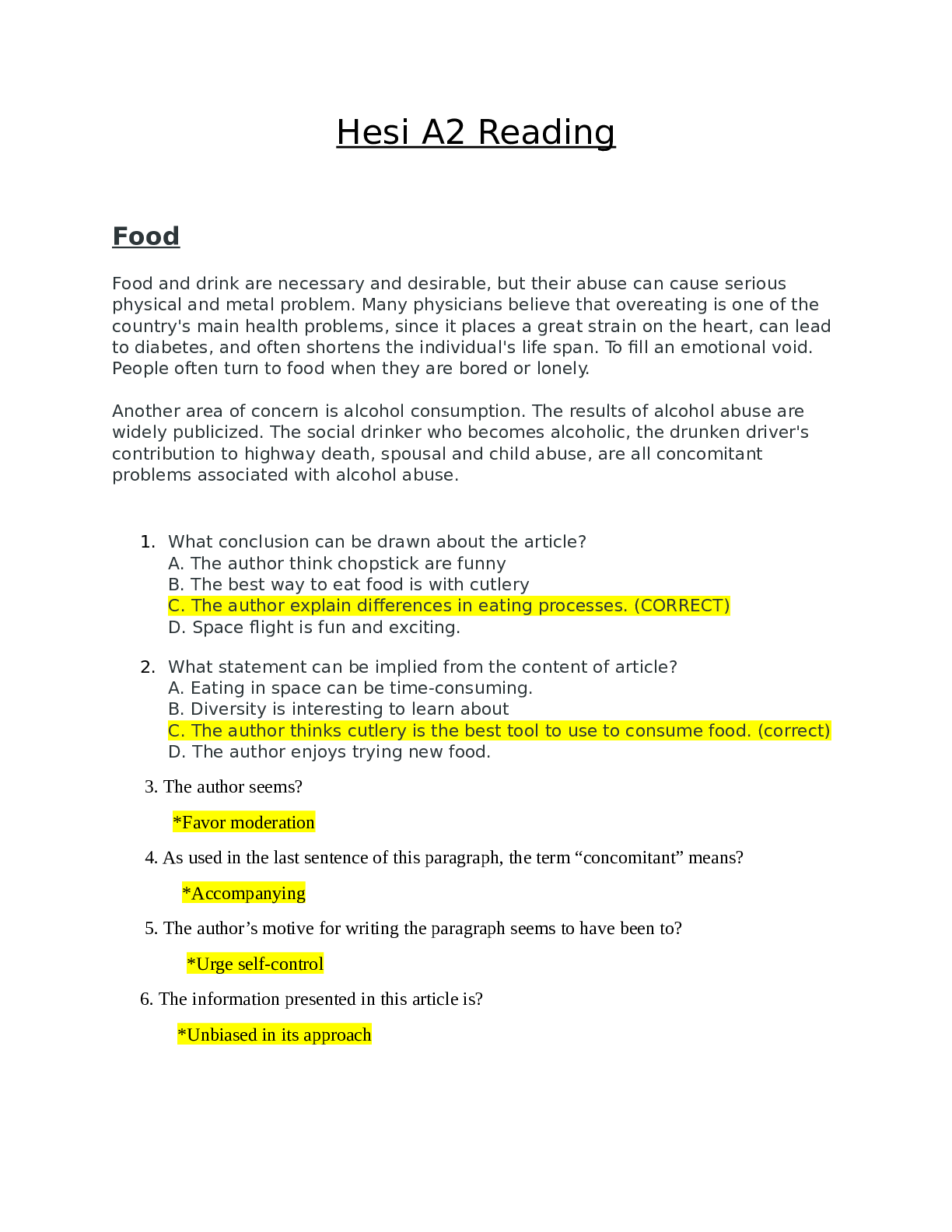
.png)
